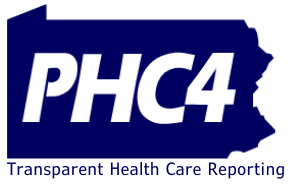Contact: Joe Martin
717-232-6787 or
PHC4 RELEASES RECENT FINDINGS ON PAâS âSUPER-UTILIZERSâ OF HOSPITAL CARE
Harrisburg, PA – June 20, 2017 – Super-utilizersâpatients with five or more hospital admissions per yearâaccounted for an estimated $1.25 billion in hospital payments in 2016, according to a new research brief released today by the Pennsylvania Health Care Cost Containment Council (PHC4).
While super-utilizers represent a relatively small percent of patients, they tend to consume a larger proportion of health care resources. PHC4âs analysis shows that super-utilizers represent:
- 3% of hospitalized patients (21,968 individual patients)
- 10% of hospital payments (estimated $1.25 billion)
- 12% of hospital admissions (141,808 admissions)
- 15% of hospital days (844,806 days)
âMany of Pennsylvaniaâs super-utilizers have chronic health needs. Results from this brief can help policy makers and health care professionals determine the best approach to care for these patients while containing costs,â said Joe Martin, executive director of PHC4.
The data shows higher rates of super-utilizers among black, lower income and older residents. Statewide, there were 21.7 super-utilizers per 10,000 Pennsylvania residents. For black residents, the rate was 39.3. For lower income residents, the rate was 38.8. Residents age 75 years and older had a rate of 55.0 per 10,000.
Of the $1.25 billion in estimated payments, almost 80% of those payments were for Medicare and/or Medicaid patients:
- $581 million for Medicare patients
- $170 million for Medicaid patients
- $239 million for patients covered by both Medicare and Medicaid
Super-utilizers are often hospitalized for a variety of reasons. Statewide, the top three reasons super-utilizers were admitted to the hospital included sepsis, heart failure and mental health disorders. Diabetes and alcohol/substance abuse disorders were in the top three for Medicaid patients.
Information on super-utilizers is especially important at the local level as it provides opportunities to address the health care needs of particular communities. The brief displays the number of super-utilizers per 10,000 residents for each of Pennsylvaniaâs 67 counties, along with the top reasons for super-utilizer admissions by county. In 2016 sepsis was the top reason for super-utilizer admissions for almost 45% of the counties (30 out of 67)âup from 16% of the counties in 2012 (11 out of 67). Overall, 88% of the counties (59 out of 67) had sepsis as one of the top three reasons super-utilizers were hospitalized. About 80% (53 out of 67) of the counties had heart failure as one of the top three and 72% (48 out of 67) had mental health disorders as one of the top three.
The brief is available on PHC4’s website at www.phc4.org. You can also link to it through social media on Facebook and Twitter.
PHC4 is an independent state agency charged with collecting, analyzing and reporting information that can be used to improve the quality and restrain the cost of health care in Pennsylvania.

